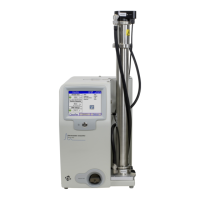Theory of Operation B-17
Multi p l e C harge C o r r ection
The data inversion described in SMPS Measurement Theory above is
based on the assumption that all particles leaving the DMA with the
monodisperse flow are singly charged. Especially when the measured
aerosol contains larger particles, there will be particles with more than one
charge in the monodisperse flow, see Charging Theory. These particles
with higher charge levels will be detected as smaller particles and hence
will cause an error in the inverted particle size distribution. Multiple Charge
Correction eliminates this error by removing the contribution of smaller,
multiply charged particles.
An important requirement must be met for the correction: The largest bin
containing particles may only contain singly charged particles. This is true
either if the particle size distribution does not contain particles larger than
the upper boundary of the selected SMPS measurement range or if the
SMPS inlet impactor nozzle is chosen so that the inlet impactor removes
such larger particles.
Starting from the topmost size bin j, the multiple charge correction for up to
6 charges follows Equation B-12. The calculation of the fractions of
particles with p elementary charges f
p,j
is described in Charging Theory.
Equation B-12
Diffus i o n Loss Co r r ection
To understand why Diffusion Loss Correction, is needed, it is necessary to
recall three facts:
1. When aerosol particles collide with a surface they adhere due to van
der Waals force, electrostatic force and surface tension.
2. Diffusion is the primary transport mechanism for particles smaller than
0.1 µm (100 nm).
3. The smaller the particle the more rapid the diffusion.
Thus, if an aerosol particle diffuses to the wall of its measurement flow
path, there will be diffusion losses, and the measured size distribution will
under-represent small particles. Since the Scanning Mobility Particle
Sizer
TM
(SMPS
TM
) spectrometer measures particles in the size range of
1 nm to 1000 nm, diffusion losses are unavoidable. They are however,
quantifiable.
Diffusion losses are frequently characterized in terms of penetration P
through a tube:

